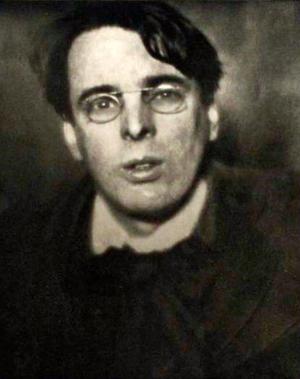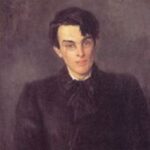William Butler Yeats, born 1865, rose to prominence as a worldwide literary figure during his lifetime and secured his position as the most well-known Irish poet unto this day. W.B. Yeats, who won the 1923 Nobel Prize in Literature, spearheaded the Irish Literary Revival. Also a playwright, Yeats founded the famous Abbey Theatre with other Revival luminaries including Lady Gregory and Edward Martyn. This Dublin theatre, opened in 1904, later became known as the National Theatre of Ireland and is still active despite losing its original building to a fire in 1951. The considerable popular success of the theatre in its early years was overseen by Yeats, who served as its chief.
W.B. Yeats published a considerable volume of work throughout his long life, dying in 1939 at age 73. His best known work is the 1919 (published in 1920) poem “The Second Coming” written shortly after the First World War:
Turning and turning in the widening gyre
The falcon cannot hear the falconer;
Things fall apart; the centre cannot hold;
Mere anarchy is loosed upon the world,
The blood-dimmed tide is loosed, and everywhere
The ceremony of innocence is drowned;
The best lack all conviction, while the worst
Are full of passionate intensity.
Surely some revelation is at hand;
Surely the Second Coming is at hand.
The Second Coming! Hardly are those words out
When a vast image out of Spiritus Mundi
Troubles my sight: a waste of desert sand;
A shape with lion body and the head of a man,
A gaze blank and pitiless as the sun,
Is moving its slow thighs, while all about it
Wind shadows of the indignant desert birds.
The darkness drops again but now I know
That twenty centuries of stony sleep
Were vexed to nightmare by a rocking cradle,
And what rough beast, its hour come round at last,
Slouches towards Bethlehem to be born?
Yeats’s “The Second Coming” showcases his characteristic style. Though he was a Symbolist poet, unlike other modernists Yeats did not give up on traditional forms to adopt the free verse taken up by many of his peers. The poem’s imagery reflects his mystical inclinations; his earliest work frequently invoked Irish folklore, and the work written toward the end of his life drew on his interests in the Hindu religion and the occult. Though not among his earliest poems, “The Second Coming” hearkens back to the apocalyptic themes associated with the mysticism of his earlier years.
Given the poem’s historical context of the World War that had just decimated Europe, many read “The Second Coming” as a commentary on European civilization’s decline rather than the more direct interpretation of its apocalyptic mysticism. Whatever Yeats intended, the powerful rhythm and terrifying imagery resonated with readers and propelled the poem to its lofty status not only as one of the best known works by an Irish poet, but as one of the most widely read poems in the world.
William Butler Yeats died in France in 1939 after living much of his late life away from Ireland. He was buried near his place of death in Menton, as per his instructions to conclude his affairs quickly. Yeats had also requested, however, than in a year’s time once attention had faded he would like his body moved to Ireland. This request went unfulfilled for some time, but finally in 1948 Ireland’s current Minister of External Affairs, Sean MacBride, oversaw the transfer of Yeats’s remains to his final resting place in Drumcliffe, Ireland.





